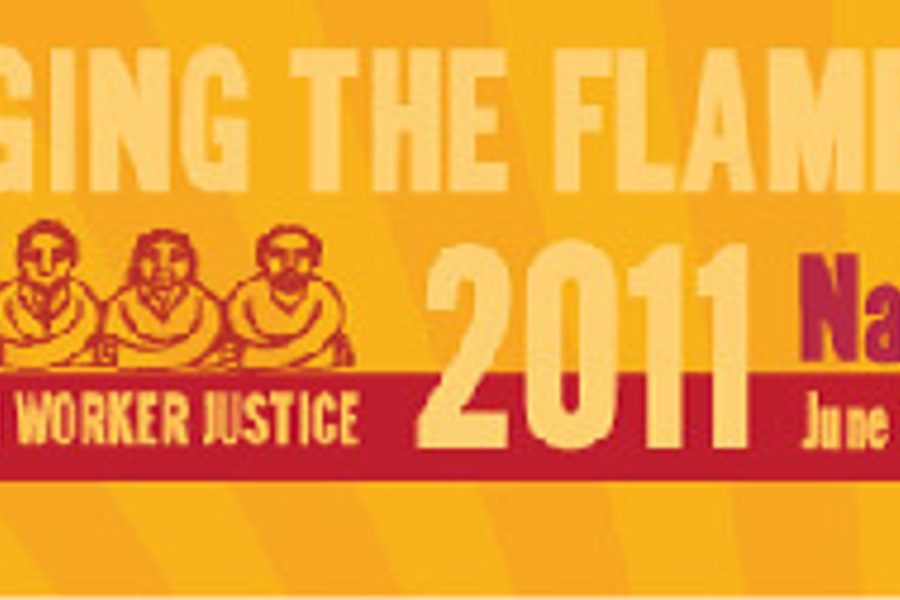
Several hundred clergy and religious community activists joined picket lines in downtown Chicago Monday in support of Hyatt hotel workers on a one-day strike for a new contract.
This was nothing new for most of them. As members of the roughly 60-plus affiliates of Interfaith Workers Justice, they had often provided such aid and comfort to workers in their hometowns around the country.
They were meeting in Chicago to celebrate the 15th anniversary of the founding of their modest-sized but highly effective nationwide network, including around 20 worker centers. An influential ally of the labor movement and of workers because of the moral standing its members have in their communities, IWJ has especially aided the most vulnerable workers. Those include immigrants and low-paid workers, whose employers often further abuse them by refusing to pay what they owe — “wage theft,” a term IWJ and its founder/executive director Kim Bobo popularized.
The roots of IWJ date back over 15 years. Then a staff member at the Midwest Academy, which trains organizers, Bobo founded the Chicago Interfaith Committee on Worker Issues in 1991 and ran it as a volunteer for four years. Bobo had grown up in an evangelical Christian family, and she had worked for the religiously based anti-hunger organization, Bread for the World, for a decade.
Although she saw the values of the labor movement and her evangelical faith as very similar, she first began to investigate possible cooperation between religious communities and labor unions as a result of her Midwest Academy work and her experience supporting the United Mineworkers’ 1989 strike at Pittston Coal. Talks with progressive clergy in Chicago, like the late Msgr. John Egan, further encouraged her. And by 1995, with the election of John Sweeney as head of the AFL-CIO, she decided to take on the work full-time and start a nationwide group. “The work felt like some of the most important work I was doing,” she says.
The Chicago group continued its local activities, which in 2002 expanded to include a worker center, an office where workers with grievances against an employer — but typically with no union — could come to get help, for example, to win unpaid back wages. Many of the workers were Polish or Guatemalan immigrants.
Soon the Chicago Interfaith Committee — renamed Arise Chicago in 2009, echoing both liturgical and revolutionary exhortations — published and distributed many thousands of Workers’ Rights manuals in Spanish, English and Polish. Now, worker center director Adam Kader says, the center doesn’t just intervene to help workers get their money but teaches people about their rights, how to reach out to other workers, and to recognize that their problems are not just personal.“The hope is people will see this as a social problem, not personal, and realize we can do things when we work together,” Kader says.
To get help from the Arise Chicago worker center, any of the average of two to 10 callers a day must also help with gathering information, reaching out to other workers, attending meetings, educating themselves, and developing their leadership skills. In a typical case, the worker center steadily escalates pressure from a phone call to the employer seeking resolution to demonstrations at the business, ultimately backed up with lawsuits. Whenever possible, however, the worker center prefers direct action. Kader then encourages workers to become members of the center, and a few campaigns link up with unions and organizing drives.
Backing from religious figures gives many workers confidence they’re on the right side of justice, helps win community support and often softens employers. “We come with clerical collars — and people respect that,” says Arise Chicago executive director C.J. Hawking. “I’m not saying it’s all that easy. The workers have usually been through tumultuous times.”
Besides such campaigns, Arise Chicago and other IWJ affiliates have promoted “labor in the pulpits” (Labor Day Sunday remarks in churches by union members) “art and labor” exhibits, “seminary summers” (placement of seminarians with affiliates to learn first-hand about fighting social injustice), and other programs to reinforce labor rights and respect.
IWJ may recruit mainly — and understandably — clergy who are already sympathetic to progressive causes. But it does direct religious community attention beyond traditional service goals of caring for the hungry and homeless to transformative goals of strengthening the rights and power of workers. And that can help to prevent the by-products of abusive employment relations, giving labor the dignity most religious traditions insist it — and the laborer — deserve.
David Moberg, a former senior editor of In These Times, was on staff with the magazine from when it began publishing in 1976 until his passing in July 2022. Before joining In These Times, he completed his work for a Ph.D. in anthropology at the University of Chicago and worked for Newsweek. He received fellowships from the John D. and Catherine T. MacArthur Foundation and the Nation Institute for research on the new global economy.








